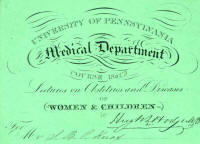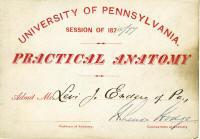Hugh
Lenox Hodge, M.D.


Click image to enlarge
Go to lecture card display
The name of Hugh Lenox Hodge, the
obstetrician, is associated with the mechanism of labor, with his
obstetrical forceps, and with a pessary. . Hugh Hodge was the son of Dr.
Hugh and Maria Blanchard Hodge, and was born in Philadelphia, June 27,
1796. His father, after heroic efforts to help, fell a victim in the
yellow fever epidemic of 1797, and died in 1798, leaving his widow with
one boy, Charles, besides Hugh. She used fine self- denial to educate
them, and at fourteen Hugh entered Nassau Hall, Princeton, and studied
medicine afterwards with Dr. Caspar Wistar, matriculating at the
University of Pennsylvania, and taking his M. D. there in 1818. Very
anxious to go to Europe, he tried to get the money by taking a surgeoncy
on a ship going to India, but returned hi two years, minus the money,
but richer in experience, through work in the cholera hospitals and the
study of tropical diseases. For one year he was physician to the
Southern Dispensary and to the Philadelphia Dispensary, then he took Dr.
Homer's (q. v.) anatomical class while the latter was in Europe, and was
later a lecturer on the principles of surgery at the Medical Institute.
In 1828, being well established in practice, he married Margaret E.,
daughter of John Apinwall, a New York merchant, and had seven sons.
When Dr. Dewees (q. v.) resigned the chair of obstetrics in the
University of Pennsylvania, Dr. Hodge was elected and was also physician
to the lying-in department of the Pennsylvania Hospital. He was led to
change from surgery to obstetrics by failing eyesight. Year by year his
private practice increased and he began to relinquish obstetrics and
devote himself almost exclusively to treating the diseases of women,
and, following up Dewees' work, in inventing and using pessaries for
uterine displacement, devoted himself for years to the discovery of the
proper materials and shapes, having hundreds made of various kinds. The
case which first attracted his attention to the value of mechanical
support was that of a woman, who in 1830 came to the hospital ward with
a diagnosis of hepatic disease. The usual treatment, including a course
of mercury, left her worse. The resident physician on making an
examination, found decided retroversion of the uterus. Hodge introduced
one of the then new Dewees pessaries and to his astonishment the liver
complaint was cured and the woman speedily restored to health. Sitting
one evening in the university "his eyes rested on the upright steel
support designed to hold the shovel and tongs which were kept in
position by a steel hook and as he studied its supporting curve, the
longed-for illumination came and the lever pessary was the result."
Afterwards he perfected his discovery by giving the instrument its
double curve and making it closed. He also modified the obstetric
forceps and Bau- delocque's cephalotribe and his cranitomy scissors.
Some thirty years' experience of hospital and private practice made his
book on "Diseases Peculiar to Women" (1860) particularly valuable. On
the resignation of his professorship, he devoted himself to his great
work, "Principles and Practice of Obstetrics" (1864), which he dedicated
to the memory of James (q. v.) and Dewees, and fulfilled its promise of
being "in opposition to the most admired authors." From its
philosophical character, as well as its original teachings and
illustrations it ranked among the first of its kind, both in America and
abroad.
He was led to resign his professorship on account of failing eyesight, a
weakness in the optic nerve, which could not be relieved by surgical
skill. At last he was unable to read and write, but his will was
indomitable. For his great obstetrical work he had to rely on an
amanuensis, and such help as his medical confreres gladly rendered.
Sixty-seven years old, he did all the professional work which could be
done without eyes. The poor and the students could still count upon
finding him in a serene mind, tender and sympathetic and with loyal,
unswerving trust in God. He generously, at this time, presented the
college with his valuable museum, together with his collection of
material used in making the one hundred and fifty- nine illustrations in
his book. It is kept separate and under the curatorship of the professor
of obstetrics.
The day before his last illness he seemed in his usual health, and was
working till late afternoon with professional engagements and preparing
an article on "Cephalotripsy." He went to bed perfectly well, but near
midnight was seized with heart failure, and died twenty- six hours
later, on February 26, 1873.
He was a fellow of the College of Physicians, Philadelphia; professor of
obstetrics, University of Pennsylvania, 1835-1863; emeritus professor in
1863; LL. D. University of Pennsylvania, 1871.
Hist, of the Penn. Hosp. Morton and Woodbury 1895.
Standard Hist, of the Med. Profess., in Philadelphia, F. P. Henry, 1897.
Biogr. Memoir by W. Goodell, M. D., Philadelphia, 1874.
(The personal edited research
notes of Michael Echols, the source of which may or
may not be completely documented)

